Even as World War II was still being fought and billions of rounds of 30-06 ammunition were being manufactured in arsenals across the country, the US Army began looking toward a new generation of small arms. More specifically they envisioned a new “light rifle†to take the place of the 30 Carbine and M1 Garand, firing a smaller cartridge but still maintaining the range and power of the 30-06.
In 1944 the Chief of Ordnance instructed the Frankford Arsenal to develop such a round. The Arsenal bought a supply of commercial 300 Savage brass from both Winchester and Remington and assembled them into test cartridges to determine pressures, velocities, and appropriate powders and primers. Once it was established that the project was feasible the Arsenal produced 10,000 new cases for further development and designated the new cartridge as the T-65. Over the course of the next 5 years the cartridge went through several design changes including neck length, shoulder angle, and case length. The final design was approved in 1949 and continued in use until August 1954 when it was standardized as the 7.62 x 51 NATO. In 1952 the Chief of Ordnance gave Winchester permission to use the case commercially . Winchester first called the new cartridge the 30-80 WCF but the name was quickly changed to what we know it as today, the 308 Winchester.
Adoption of any cartridge by the military means almost immediate use in competition. Even before adoption by NATO, the 308 National Match ammunition was being manufactured by the Lake City Arsenal for use in Service Rifle matches. Palma competition requires the use of the 308 cartridge loaded with a special 155 grain Palma Hollow point bullet. Benchrest shooters found the round to be competitively accurate although the substantial recoil limited it’s use almost exclusively to Heavy Bench or Unlimited Class rifles. Long Range benchrest shooters use the 308 in competition with long, heavy VLD bullets. But where the 308 case excels in competition is in the various wildcats of every imaginable size and shape, so numerous that they will be left for another chapter.
Pictured below left to right are,1) the original prototype using a 300 Savage case, ,2 ) T65 with 30 degree shoulder and 47mm case,,3) 49 mm case with 30 degree shoulder,,4) the final version, a 51mm case with 20 degree shoulder. ,5) Is a 308 Winchester Silver Tip. The various full length competition rounds that follow are,6) a Benchrest loading with a 168 grain Sierra HP,,7) an M118 National Match round with 173 grain BT bullet,,8) a Palma round with 155 grain bullet, and,9) a Long Range benchrest round with a 175 grain VLD bullet.
In 1944 the Chief of Ordnance instructed the Frankford Arsenal to develop such a round. The Arsenal bought a supply of commercial 300 Savage brass from both Winchester and Remington and assembled them into test cartridges to determine pressures, velocities, and appropriate powders and primers. Once it was established that the project was feasible the Arsenal produced 10,000 new cases for further development and designated the new cartridge as the T-65. Over the course of the next 5 years the cartridge went through several design changes including neck length, shoulder angle, and case length. The final design was approved in 1949 and continued in use until August 1954 when it was standardized as the 7.62 x 51 NATO. In 1952 the Chief of Ordnance gave Winchester permission to use the case commercially . Winchester first called the new cartridge the 30-80 WCF but the name was quickly changed to what we know it as today, the 308 Winchester.
Adoption of any cartridge by the military means almost immediate use in competition. Even before adoption by NATO, the 308 National Match ammunition was being manufactured by the Lake City Arsenal for use in Service Rifle matches. Palma competition requires the use of the 308 cartridge loaded with a special 155 grain Palma Hollow point bullet. Benchrest shooters found the round to be competitively accurate although the substantial recoil limited it’s use almost exclusively to Heavy Bench or Unlimited Class rifles. Long Range benchrest shooters use the 308 in competition with long, heavy VLD bullets. But where the 308 case excels in competition is in the various wildcats of every imaginable size and shape, so numerous that they will be left for another chapter.
Pictured below left to right are,1) the original prototype using a 300 Savage case, ,2 ) T65 with 30 degree shoulder and 47mm case,,3) 49 mm case with 30 degree shoulder,,4) the final version, a 51mm case with 20 degree shoulder. ,5) Is a 308 Winchester Silver Tip. The various full length competition rounds that follow are,6) a Benchrest loading with a 168 grain Sierra HP,,7) an M118 National Match round with 173 grain BT bullet,,8) a Palma round with 155 grain bullet, and,9) a Long Range benchrest round with a 175 grain VLD bullet.











